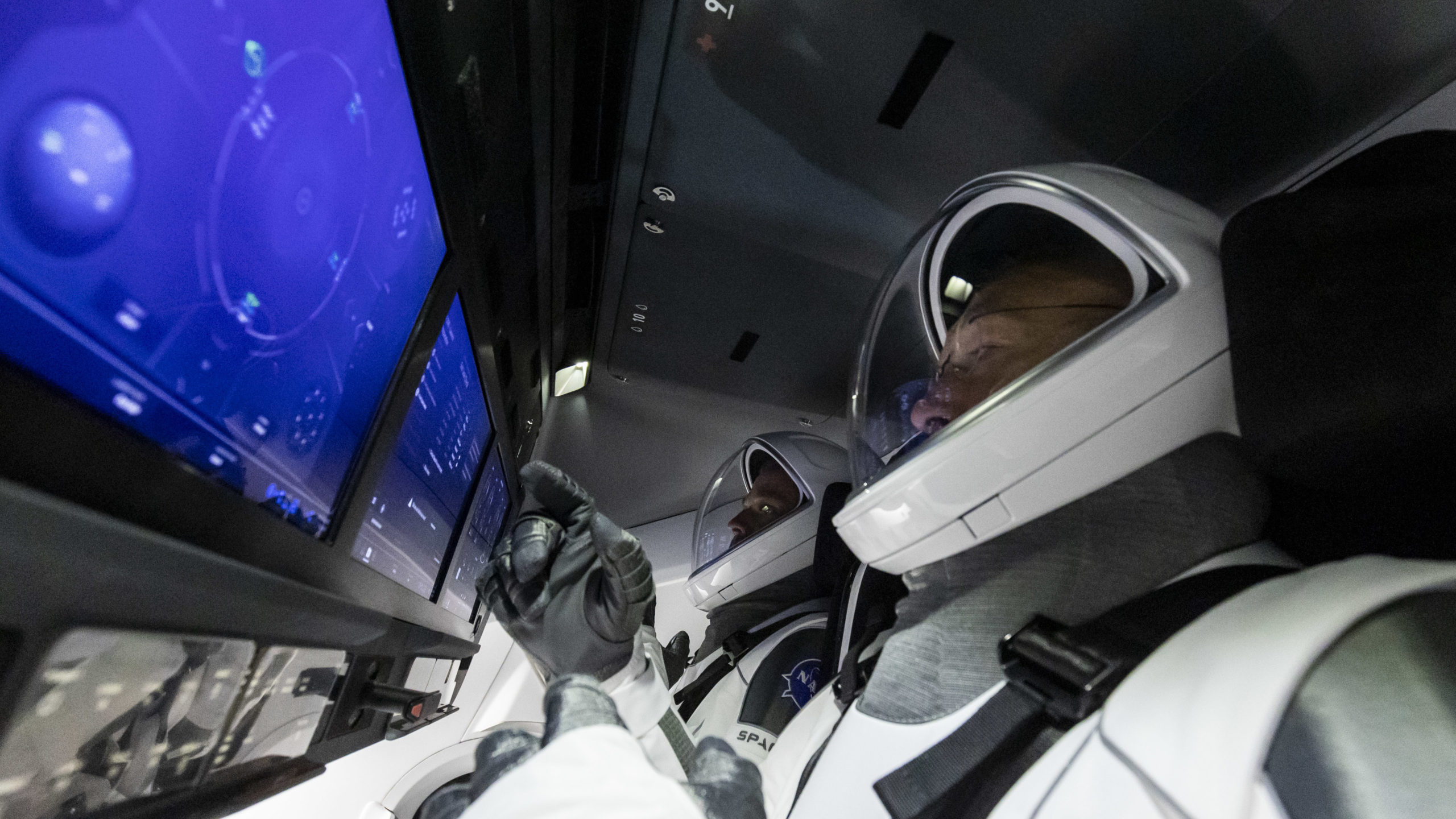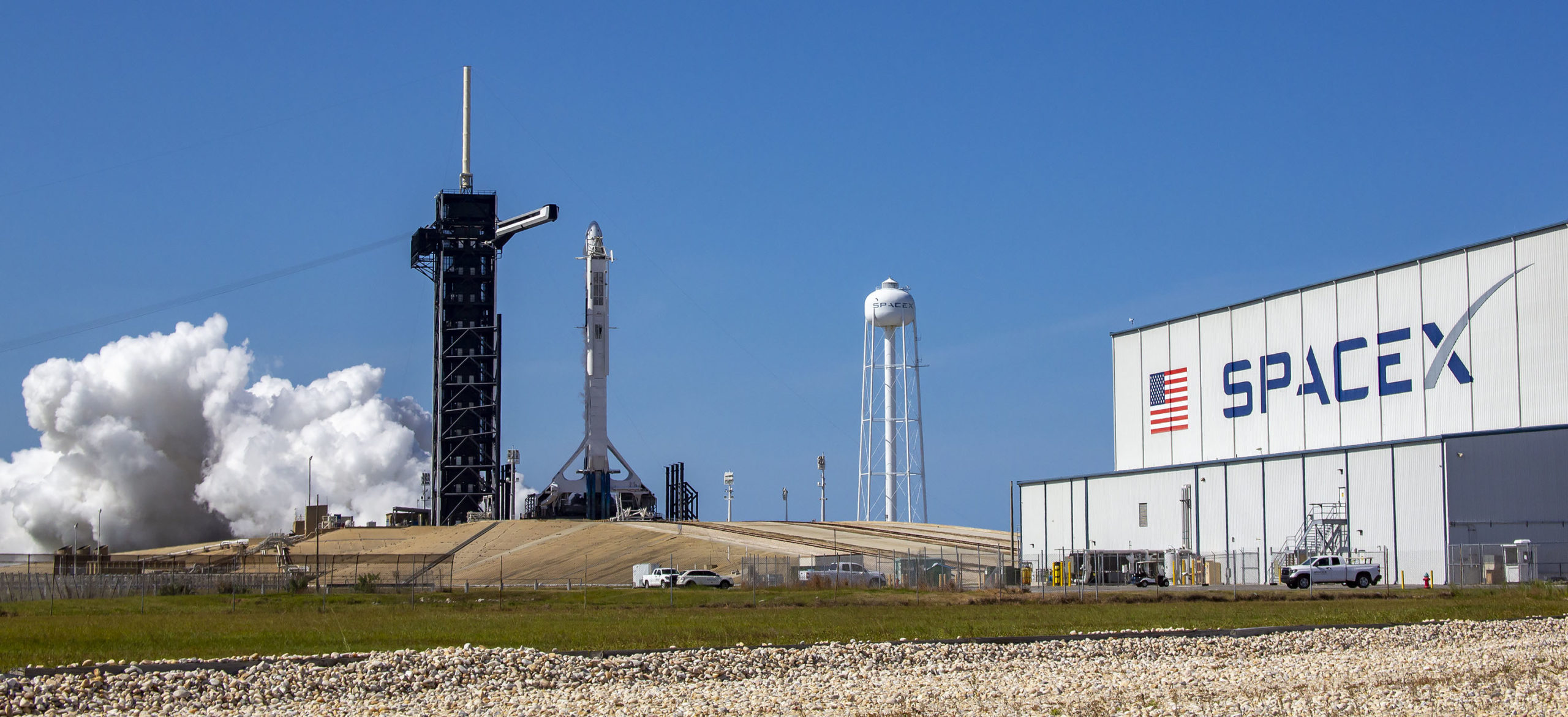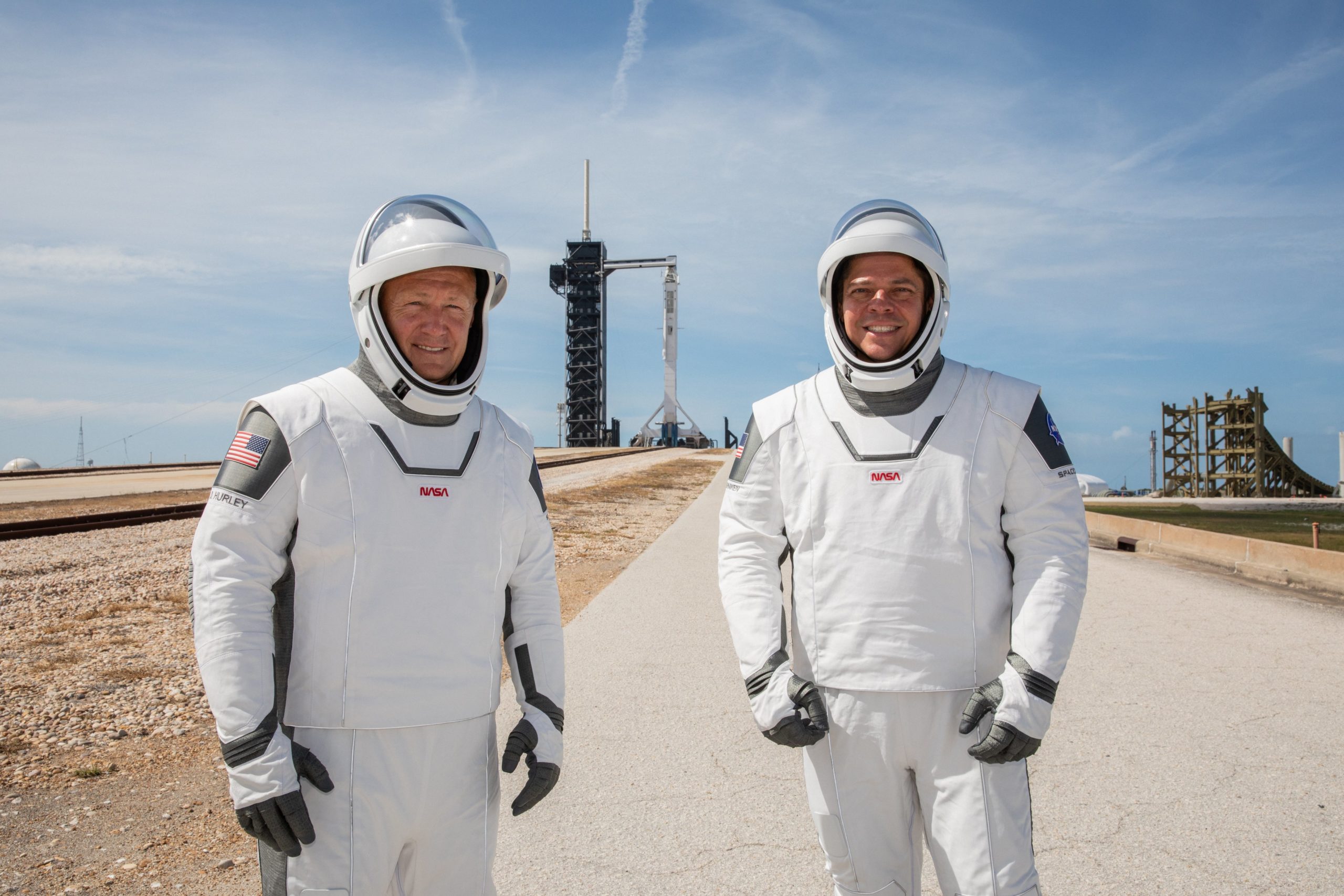
For the first time in nearly nine years, a Prime Crew is in the final days of waiting at the Kennedy Space Center (KSC) in Florida, ahead of their scheduled liftoff from historic Pad 39A at 4:33 p.m. EDT Wednesday, 27 May. Retired Marine Corps Col. Doug Hurley, who piloted the final voyage of the shuttle program, and Air Force Col. Bob Behnken, a former chief of NASA’s astronaut corps, will fly SpaceX’s Crew Dragon for the long-awaited Demo-2 mission to the International Space Station (ISS).
The Launch Readiness Review (LRR) wrapped up today, clearing a final significant milestone before Wednesday’s liftoff. “We’re burning down the final paper. All the teams are a go, and we’re continuing to progress toward our mission,” said Kathy Lueders, manager, NASA Commercial Crew Program. “I’m very proud of the team. We are continuing to be vigilant and careful, and make sure we do this right.”
Follow our LAUNCH TRACKER for daily updates & live coverage on launch day!
The pair arrived at the Cape aboard a NASA Gulfstream V business jet last week, unlike most shuttle crews from years gone by, who typically utilised T-38s to move cross-country from their home in Houston, Texas, to their launch site in Florida. This “different” way of doing business will also see Hurley and Behnken ride in the backseats of a pair of Tesla Model X cars to the pad next week, as opposed to the air-conditioned Airstream “astrovan” of the past.
It was a warm Independence Day nine years ago in 2011, when STS-135 Commander Chris Ferguson, Pilot Doug Hurley and Mission Specialists Sandy Magnus and Rex Walheim—all brandishing small U.S. flags which fluttered gently in the mid-afternoon breeze—arrived at KSC ahead of the last shuttle flight. “We’ll be very proud to put the right-hand bookend on the Space Shuttle Program,” Ferguson told the gathered knot of journalists, before introducing Hurley for his remarks.
Little could either of them have known that, nine years later, both would be training to fly the maiden vehicles of NASA’s Commercial Crew partners. Ferguson will ride Boeing’s CST-100 Starliner early next spring, whilst Hurley launches with Behnken on Wednesday to kick off a new era of U.S. human spaceflight, aboard U.S.-built space vehicles, launched atop U.S. rockets, and from U.S. soil.

A key element of the “bookend” left by STS-135 is the presence of a small U.S. flag, currently aboard the space station. It was put there by Ferguson’s crew, having also flown aboard the very first Space Shuttle mission in April 1981. The intention is that it would be brought back to Earth by the next crew to launch from the Space Coast, before flying again on the next piloted voyage of exploration beyond low-Earth orbit. The Demo-2 crew expects to grab the flag from incumbent Expedition 63 Commander Chris Cassidy and put it somewhere safe for the return to Earth.

“No one wants to see this mission be a success more than us,” Behnken told reporters at KSC last Wednesday. “And we don’t want to be the folks that don’t make it successful.” The duo have been training as part of a Commercial Crew cadre of astronauts since July 2015 and as dedicated Demo-2 crewmen since August 2018. Their test flight was originally planned to last one or two weeks, but as the Commercial Crew Program experienced lengthier delays the possibility arose that the ISS would operate on a significantly reduced U.S. staff throughout most of 2020.
As such, late last year, efforts entered high gear to repurpose Hurley and Behnken’s mission from a short visiting test flight into a longer stay. This situation was aided by the fact that “their” Crew Dragon for Demo-2 is not the one they initially planned to fly. An explosion of the Demo-1 capsule during post-flight tests last year obliged SpaceX and NASA to utilize Hurley and Behnken’s “original” spacecraft to fly the In-Flight Abort test in January 2020 and the astronauts will correspondingly now fly the ship previously earmarked for the long-duration Crew One, the first operational Crew Dragon.

At present, it remains unclear how long Demo-2 will last, with Hurley indicating a duration of between one and four months, the maximum length determined primarily by the lifespan of Crew Dragon’s body-mounted solar arrays. Earlier in May, NASA identified a minimum stay of about 30 days and a maximum of 119 days, potentially resulting in a return to Earth and splashdown as late as the middle of September.

Liftoff remains targeted for 4:33 p.m. EDT on Wednesday, although the 45th Weather Squadron at Patrick Air Force Base envisages only a 40-percent likelihood of acceptable conditions for the “instantaneous” launch window, noting that potential violating factors include flight through precipitation and potential breaches of the Cumulus Cloud Rule and Thick Cloud Rule. Deep tropical moisture from a low-pressure area brought showers, isolated thunderstorms and extensive cloudiness into Central Florida over the weekend, producing a situation which may linger on Wednesday.
“On launch day, remnant moisture will still be present,” noted the Sunday morning update, “but the moisture’s depth will depend on the location of development of the low-pressure area.”
However, 45th Weather Squadron Launch Weather Officer Mike McAleenan pointed out things are looking up.
“It certainly has been trending better over the last day or two for launch weather,” McAleenan said. “If I was to issue the forecast today, right now, we would probably be down to 40% chance of violation.”
As reported previously by AmericaSpace, Hurley and Behnken arrived at the Cape last Wednesday, to be greeted by a socially-distanced gathering of journalists and senior NASA personnel, including Administrator Jim Bridenstine and KSC Director and former shuttle commander Bob Cabana. The 230-foot-tall (70-meter) Falcon 9 booster—whose B1058 first-stage core will be making its first launch—was transported from the Horizontal Integration Facility (HIF) to Pad 39A last Thursday, then raised to the vertical. With the Crew Dragon in place, the booster underwent a customary Static Fire Test of its nine Merlin 1D+ first-stage engines, lasting about seven seconds, on Friday. The success of the test and completion of a two-day Flight Readiness Review (FRR) led to confirmation from SpaceX and NASA that the team would press ahead towards an opening launch attempt on the 27th.

On Saturday, Hurley and Behnken participated in a full “Dry Dress” rehearsal for the tasks they will do for real on Wednesday. They donned their individually-customized SpaceX launch and entry suits, departed the Neil Armstrong Operations & Checkout Building and rode the Teslas—complete with “ISSBND” license plates—out to the pad. Together with support teams, they ascended the 39A gantry to the 217-foot (66-meter) level, then walked along SpaceX’s sleek 85-foot-long (25-meter) Crew Access Arm to enter the spacecraft. The two astronauts, with Hurley in the left-hand seat as mission commander and Behnken in the right-hand seat as joint operations commander, conducted communications checks and Crew Dragon’s hatch was closed. The rehearsal concluded with the “Go/No-Go” poll for Falcon 9 propellant loading, which will get underway at T-45 minutes on launch day.
Shortly after this Go/No-Go stage is reached for real on Wednesday, the Crew Access Arm will retract and Crew Dragon’s Launch Escape System will be placed onto internal power and armed. Fueling of the booster with a highly refined form of rocket-grade kerosene (RP-1) will commence at T-35 minutes, accompanied by the onset of liquid oxygen tanking into the first stage. Liquid oxygen will then be pumped into the Falcon 9’s second stage from T-16 minutes and Crew Dragon will transition to internal power at T-5 minutes.

As the following minutes tick away, the casual observer might think that an “ordinary” Falcon 9 is about to take to the skies, before the harsh realization that for the first time since the retirement of the Space Shuttle there are humans just like you and me on this one. And as SpaceX President Gwynne Shotwell recently remarked, Hurley and Behnken may be pilots, engineers and astronauts, with more than a touch of “badass” about them, but they are also husbands and fathers. Indeed, Hurley’s wife—former astronaut Karen Nyberg, who recently retired from NASA after two space missions and nearly 180 days of cumulative time in orbit—tweeted a touching photograph of their son as they flew into KSC for the launch. “Arriving in Florida with a flyby of your dad’s spaceship on the launch pad,” she told her 299,600 Twitter followers. “Priceless!”

If Wednesday’s instantaneous launch window is missed, SpaceX and NASA will stand down for three days before trying again in two back-to-back opportunities at 3:22 p.m. EDT Saturday and 3:00 p.m. EDT Sunday.

Following liftoff, Hurley and Behnken will ride the fire and fury of the nine Merlin 1D+ first-stage engines for 2.5 minutes, before B1058 separates from the stack and passes the baton over to the Merlin 1D+ Vacuum engine of the second stage. B1058 will then return to Earth, executing a computer-controlled sequence of “burns” to alight on the deck of the Autonomous Spaceport Drone Ship (ASDS), “Of Course I Still Love You”, at nine minutes and 22 seconds after liftoff. The ASDS left port on Sunday, bound for a recovery location about 320 miles (510 km) offshore in the Atlantic Ocean.

Meanwhile, the Merlin 1D+ Vacuum engine of the second stage will burn for six minutes, before shutting down. The stack will coast for a few minutes, before the Crew Dragon separates at 12 minutes to begin its autonomous flight. The spacecraft’s nose cone will open a few seconds thereafter to reveal the star tracker and ISS docking adapter and Hurley and Behnken will commence a 19-hour trek to reach the space station. Two computer-controlled “phasing burns” will be executed at 49 minutes after launch and 9.5 hours into the mission, after which the Crew Dragon’s orbit will be fully circularized ahead of rendezvous.
Although the spacecraft is designed to be wholly autonomous, Hurley will briefly take manual control of his ship during the free-flight period and again when closer to the ISS. A little less than 18 hours after leaving the Space Coast the duo will approach the station, pausing at three key “waypoints”—the first at 1,300 feet (400 meters), the second at 700 feet (220 meters) and a final one at 65 feet (20 meters)—ahead of a final “Go/No-Go” poll from mission controllers for docking. Current planning calls for physical contact between the Demo-2 vehicle and International Docking Adapter (IDA)-2 on the forward end of the Harmony node to occur a little over 19 hours into the mission.

Following pressurization and leak checks, the hatches will be opened and Hurley and Behnken will be greeted by Expedition 63 Commander Chris Cassidy and Russian cosmonauts Anatoli Ivanishin and Ivan Vagner, who are entering their sixth week in orbit. Asked recently by an interviewer about their first meeting, the Demo-2 crew related that there has been much back-and-forth email correspondence between them. Cassidy is apparently looking forward to seeing Hurley and Behnken’s “ugly mugs” on-board. Said Hurley with a grin: “I don’t particularly agree with him on that part!”
Tomorrow’s article will look at the plan for Demo-2’s stay on the ISS.
.
.
FOLLOW AmericaSpace on Facebook and Twitter!
.
.
Missions » ISS » CCDev » DM-2 »





have a nice day